Goethe's Heidenröslein
Posted by Richard on UTC 2017-06-01 11:05 Updated on UTC 2017-07-25
Surviving a little prick
This boy-soprano, before hormones released him from the torture, used to stand on stages in town halls and church assembly rooms and belt out Schubert's Heidenröslein across the front row of old ladies right to the back row of excited gentlemen. The song was one of the stars of the repertoire.
The music was great – thank you, Franz! Fingers waved and toes tapped. Even the accompanist enjoyed it, the one who had a panic attack just at the mention of Die Forelle. At the end of the piece the little singer would bow and take with gratitude the applause he got but leave the stage not totally happy – what was that song all about?
He never understood the poem Heidenröslein, so had no idea how this song, in which both parties get hurt, should be interpreted: should he be gurning happily or sadly to the old ladies? Perhaps a bit of both? Avoid all eye-contact with the back row, though! The lyrics of this most popular Lied of all were a complete conundrum to him, in any translation and ultimately in the original German. This tale of mutual combat appeared to have a moral – but what was it?
The translators didn't help. 'Saw a youth the morning rose, rose among the heather'. Unlike German, English is not an inflected language, so our first puzzle here is who saw whom; the next is what a 'morning rose' is?; finally, why is a rose growing among heather? The rest of the poem is full of puzzles: the boy disobeys, the rose suffers, the boy suffers a bit, the rose suffers terminally. So?
Blessed with Franz's great music the English translations seem to function by stacking up emotionally loaded words – youth, morning, rose, heather – without any narrative connection. People down the ages and across the world seem happy to sit on uncomfortable chairs and listen to this stuff, paying good money to hear it performed in dusty halls on Saturday afternoons by worried little boys and just-competent pianists.
Until he encountered Goethe's poem in German he put his puzzlement down to the difficulties of translation. Wrong! If anything, Goethe's original is more obscure and puzzling than the English versions. It seems as though the translators had all been doing their best to add some sense to it according to their own lights.
Let's look at all these puzzles and do our best to resolve them. Heidenröslein is a quality poem written by a genius that will repay our efforts to understand it.
Here is the German text of the lyric in its first printed form from 1789 with one of our plonkingly literal translations:
Heidenröslein
Meadow rose
Sah ein Knab' ein Röslein stehn,
Röslein auf der Heiden,
War so jung und morgenschön,
Lief er schnell es nah zu sehn,
Sah's mit vielen Freuden.
Röslein, Röslein, Röslein roth,
Röslein auf der Heiden.
A youth saw a rose standing,
Rose in the meadow,
She was young and morning-pretty,
He ran quickly to look more closely,
Saw her with great pleasure.
Rose, rose, red rose,
Rose in the meadow.
Knabe sprach: ich breche dich,
Röslein auf der Heiden!
Röslein sprach: ich steche dich,
Daß du ewig denkst an mich,
Und ich will's nicht leiden.
Röslein, Röslein, Röslein roth,
Röslein auf der Heiden.
The youth said: I'm going to pluck you,
Rose in the meadow!
The rose said: I'll prick you,
That you will remember me forever,
And I don't want to be hurt.
Rose, rose, red rose,
Rose in the meadow.
Und der wilde Knabe brach
's Röslein auf der Heiden;
Röslein wehrte sich und stach,
Half ihr doch kein Weh und Ach,
Mußte es eben leiden.
Röslein, Röslein, Röslein roth,
Röslein auf der Heiden.
And the wild youth plucked
the rose in the meadow;
The rose defended herself and pricked,
But no pain and lamentation helped her,
She just had to suffer it.
Rose, rose, red rose,
Rose in the meadow.
Goethe, Johann Wolfgang von. Schriften, Leipzig, Georg Joachim Göschen, 1789, Band 8, p. 105f.
Structure and metrics
The rhythm and liveliness of the poem are wonderful, so let's break the poetic rose in the interests of a metrical autopsy.
The poem consists of three stanzas, each comprising a five line section followed by a two line refrain – 21 lines in all. The second line in each stanza, Röslein auf der Heiden, is repeated as the last line of the refrain (allowing for the grammatically necessary [da]'s in the third). The rhyme scheme is
a-b-a-a-b-x-b
c-b-c-c-b-x-b
d-b-d-d-b-x-b
where 'a' is replaced by 'c' in stanza 1 and 'd' in stanza 2 – all the other rhymes remain constant. 'x' stands for the repeated word roth.
The metrical scheme is adhered to closely throughout the poem. It is therefore sufficient to scan just the first stanza:
Heidenröslein
Sah ein | Knab' ein | Röslein | stehn,
Röslein | auf der | Heiden,
War so | jung und | morgen | schön,
Lief er | schnell es | nah zu | sehn,
Sah's mit | vielen | Freuden.
Röslein, | Röslein, | Röslein | roth,
Röslein | auf der | Heiden.
The basic measure is the 'trochaic foot', |dum-da|. Blue marks the 'long' or 'stressed' vowels, green the 'short' or 'unstressed' vowels. Lines 1, 3, 4 and 6 in each stanza have four feet but are 'catalectic', that is, they end in incomplete trochees. We have indicated this in our mark up by ending the catalectic lines with the missing unstressed syllable: . The other lines have three complete trochaic feet.
Attentive readers will have spotted a typographic error in the text of 1789 edition, which has: Mußte | es eb | en lei | den. Mußte es breaks the scansion of the line. In defence of Goethe or the compositor, casual speakers would instinctively elide the terminal 'e' of Mußte in order to avoid the need for an unpleasant and unsingable glottal stop between the two 'e's. In later editions the error was corrected by replacing the terminal 'e' of Mußte with the formality of an apostrophe: Mußt' es | eben | leiden.

Franz Schubert's composer's ear is happy with Mußt' es. The manuscript is available online from the Staatsbibliothek zu Berlin – Preußischer Kulturbesitz.
The structure reinforces the Volkslied, 'folk song' simplicity of the poem. The lines are short and all lines are end-stopped in some way, except for the enjambment across the first two lines of the third stanza:
Und der wilde Knabe brach / 's Röslein auf der Heiden
The vocabulary is simple, only one and two-syllable words, with the exception of morgenschön, the presence of which causes sensitive philologists to flutter their fans, since such an imagistic artifice has no place in a Volkslied. Our translation of it as 'morning-pretty' is a minor affectation that is intended to reflect the minor affectation of the original.
The phrase Röslein auf der Heiden is repeated six times – meaning that even the dimmest rustic following a plough can remember the words of this song. It takes a very clever poet to write this simply.
Notes on meaning and translation
Heidenröslein
Heidenröslein? What on earth is one of those? If you find the word in a dictionary it is only because Goethe used it here. Heideröschen you will find, which most good dictionaries give with its many synonyms: Weinrose, 'wine-rose', Dornrose, 'thorn-rose', Frauenrose, 'ladies'-rose', Heiderose, 'meadow-rose', Marienrose, 'Mary's rose', Weindorn, 'wine thorn'.
The shifting folk names of wild-flowers are trickily indeterminate and Heideröschen is no exception. The latin name ascribed by German lexicographers is the fixed star that we must follow to arrive at Rosa eglanteria, which we English will recall as the eglantine that canopies Titania's bower in Act 2 Scene 1 of Shakespeare's A Midsummer Night's Dream:
I know a bank whereon the wild thyme blows,
Where oxlips and the nodding violet grows,
Quite over-canopied with luscious woodbine,
With sweet musk-roses and with eglantine;
There sleeps Titania sometime of the night,
Lull'd in these flowers with dances and delight;
Note to Shakespeare fans: we follow Alexander Pope and the older editors in writing the metrically essential 'whereon' instead of the modern, tin-eared and metrically impossible 'where'. Of course, if, like Shakespeare in the first quarto, you write 'banke', then that is a completely different story.
Shakespeare, who knew his plant lore and used that knowledge to great effect, arches two varieties of rose over Titania, the Fairy Queen: the musk-rose (Rosa moschata), famed for its heavy scent, and the eglantine. For Shakespeare's eglantine the modern would say sweet briar rose (Rosa rubiginosa/eglanteria). The word 'briar' is the clue to the feature of this rose that defends the sleeping queen: its fearsome thorns. The youth in Heidenröslein is picking on a tough opponent.
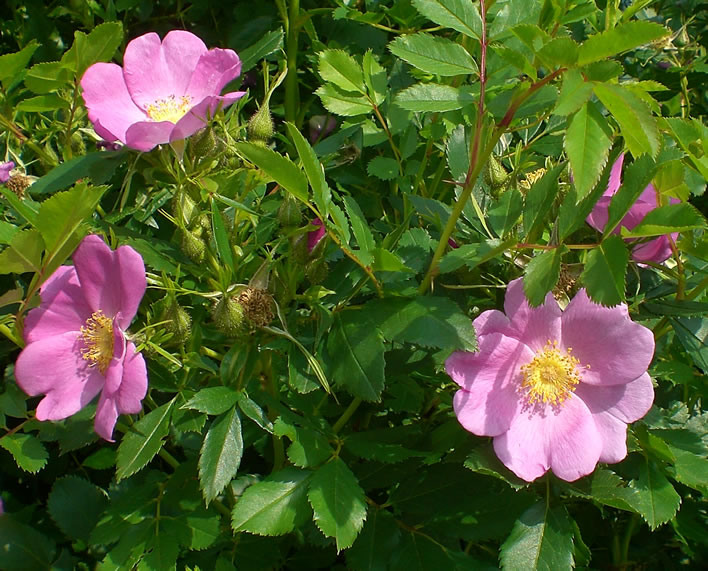
The briar rose (or one of its variants). Some of its long, spiny thorns are visible in the centre of the picture: look but not touch! Image: ©FoS.
Very fine, you are saying, but why have we translated the title as 'Meadow rose'? Because what is important here is not that the rose is the sweet briar as such, but that the rose is situated in a meadow. Which means we must now explain our translation of Heiden as 'meadow'.
Heiden
Heiden occurs six times in the poem and once in the title, so we had better get the translation right.
The root word here is Heide, which down the centuries, like most ancient words, shimmers with acquired meanings and nuances. In its original meaning it was simply land or open fields, in contradistinction to towns and villages. To cut a very long story short, it became more specifically associated with land or countryside that was not directly farmed, i.e. not used for crops or grazing. In north Germany it became associated with sandy plateaux which the British would recognise as 'heath'. In other parts of Germany Heide would be applied to any area of land that was left uncultivated – on the margins of woodland, for example, and this is what is meant by the use of Heide in this poem.
'Heath' would be a mistranslation, since it gives an impression of a near barren terrain – we reach once more to our wonderful Shakespearean language tradition and think of Macbeth's 'blasted heath'. A fragile rose is supposed to be growing in that ghastly place. Our solution 'meadow' is not perfect but less misleading. As we shall see shortly, Heiden as used here has its origin in a late medieval poem and for readers from the 18th-century to the present-day offers the fine antique patina that might be expected in the fake Volkslied.
If we want to know what Germans understand by Heide we only have to look at the visualisations in some of the many postcards on the theme Heidenröslein. The excellent Goethezeitportal has pages and pages and pages and pages of them.


That's clearer now, isn't it?
Possibly because of our modern difficulties with the meaning of Heide some translators have taken to translating the word as 'hedge' or 'hedgerow', thus creating a nice picture in the mind that recalls Brooke's clever lines in The Old Vicarage, Grantchester: 'Unkempt about those hedges blows / An English unofficial rose'. A nice picture – but 'hedgerow' is ultimately a mistranslation.
We friendless obsessives might fret about the fact that briar roses are not solitary flowers, which is what the text implies, but grow in bushes, making the presence of only a single flower improbable. We leave that observation and move on.
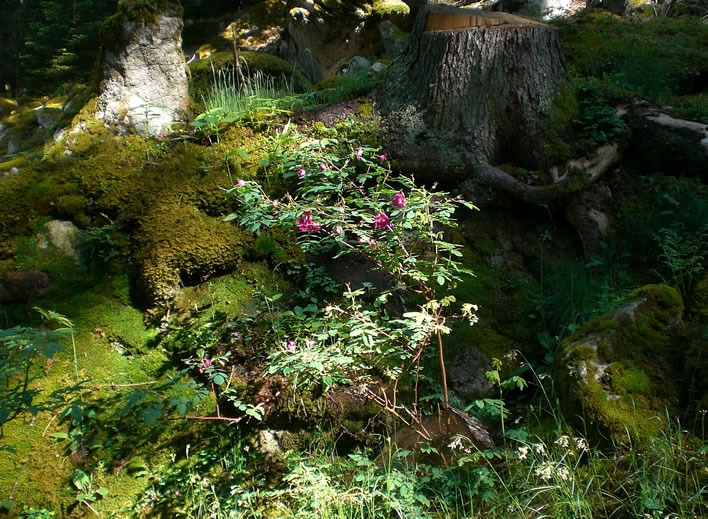
A briar rose, morgenschön, alongside a forest path at 1,500 metres above sea-level – close enough to a Heide for our present purposes. Image: ©FoS.
People who know some German might be troubled by Heiden, particularly in the phrase Röslein auf der Heiden, which to the modern speaker should be Röslein auf der Heide. Even Goethe, everything else being equal, would write Heide. Heiden is, in fact, a throwback to the Middle High German of the late Middle Ages in which a so-called weak feminine noun ending in 'e' would add an 'n' in all cases apart from the nominative singular [you may need to read that a few times!]. The current instance is the dative singular.
The feminine noun Heide does not change its internal form with changes of case and is therefore categorised as a weak declension. The late medieval farmer would find auf der Heiden perfectly correct – for the modern German speaker it is a bit of a puzzle, sounding old fashioned, which is exactly what is required.
The same remarks apply to the title, Heidenröslein, which also troubles the modern reader, who expects Heideröslein. The word is a compact form of Röslein der Heide, 'rose of the meadow' in which der Heide is the modern genitive of the weak feminine noun Heide: 'the meadow's rose'. Using the antique declension noted above, the genitive of Heide adds an 'n', thus giving us Heidenröslein.

The maker of the postcard succumbed to the pressure of modern German grammar and titled the picture Heideröslein, without the MHD 'n'. The woman is in make-up and Dirndl, with her hair in a plait. Unfortunately the roses are a cultivated garden variety. Image from Goethezeitportal.
Knab
Knabe in modern German now means incontrovertibly 'boy'. In older times Knabe was often used for a young male: a boy would be called specifically ein junger Knabe. 'Youth' – suitably thuggish – is probably the best option here. As with Heide, a glance at the Knaben in the postcard illustrations will show how wide the range of interpretations among German speakers is.
brechen
brechen, nominally 'to break', is not uncommon as a word for gathering flowers. The poet is happy to make use of its assonance with stechen to counterpose the two forms of combat.
However, modern scholars, sensitised by the feminist movement's heightened emphasis on the seriousness of rape, have chosen to see brechen as a rape metaphor, thus turning the whole poem into a rape parable. See for example [Staffeldt 526], who by judicious replacement of words changes the poem into an account of a heartless rape. Well, we can all rewrite poems for our purposes. Once we start thinking like this we have to ask what a beautiful rose is doing in an open field flashing her bloomers – it won't end well.
The modern focus on rape did not exist in the 18th-century. It is highly unlikely that such an interpretation would be in Goethe's mind, a speculation that is reinforced by the shoulder-shrug of the outcome of the battle: Mußt' es eben leiden, 'just had to suffer it' – all in all a pretty unsatisfactory ending for a feminist rape parable. The key questions that the proponents of such readings have to answer are simple: why on earth would Goethe want to write a rape parable? What is the artistic point, what lesson is to be drawn?
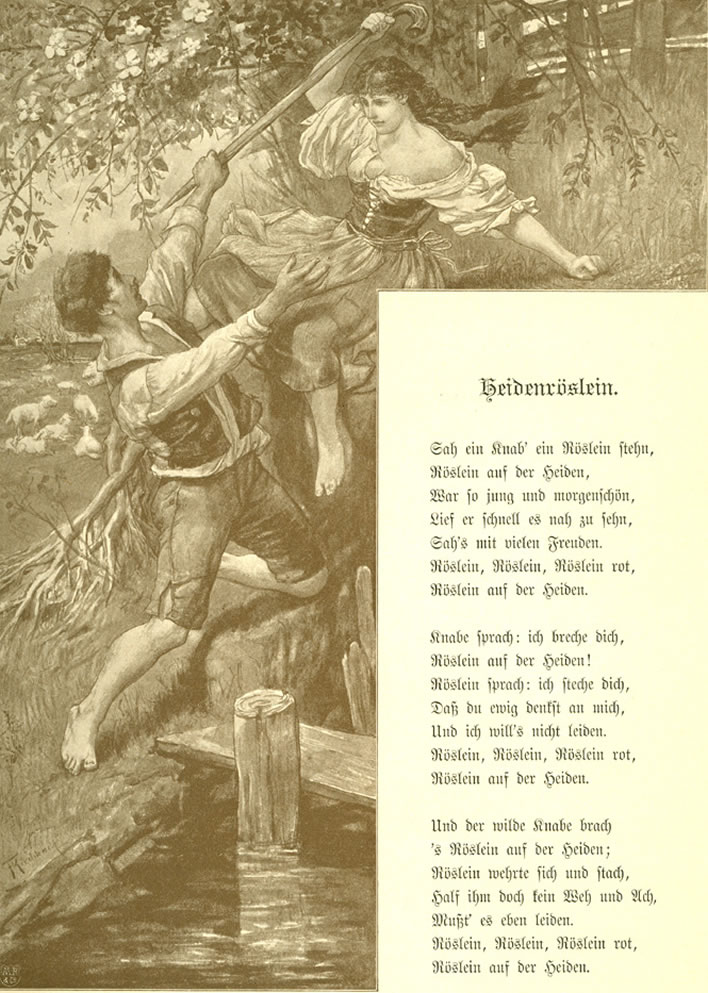
The rape fantasists will take one glance at this illustration and see their theory confirmed. However, a calmer assessment reveals that the rose is on top in this combat scene and the young man is about to get his comeuppance. This illustration is evidence of the misunderstandings caused by the use of the grammatically correct ihm as opposed to Goethe's subjugation of grammar to meaning by using ihr (see our note under ihr below). The illustrator gives us no hint that ihr, 'the rose' is suffering at all. The rose has defended herself and stabbed: it is the young man, ihm, who has to suffer the pain of that big prick and who is probably going to end up in the stream. Feminist empowerment, indeed! Image: Goethezeitportal.
Those who are unhappy with such a brusque dismissal of the rape metaphor should read Ludwig Uhland's extended review of the brechen theme in Chapter 4 of his essay 'Abhandlung über die deutschen Volkslieder' [Abhandlung 3:383-456]. About the frequency of the term he is clear: 'Die Volkslieder sind, wie der Kunstgesang, voll Blumenbrechens', 'Folk songs are, just like art songs, full of flowers being broken', but since Blumenbrechen means simply 'gathering flowers' – and has meant this down the centuries – the metaphor of rape never enters his 19th-century, unemancipated head.
Goethe was steeped in the classics, in particular Ovid's Metamorphoses, where sexual conquest is a quite predictable everyday occurrence in the grand order of things. Catullus and Propertius (a great influence) also came along in this period for Goethe, both of those Italians having, let us say, a tumultuous relationship with their respective objects of desire: innocent crockery was destroyed, blows traded, nails scraped.
stechen
'To prick' is rather weak for stechen, but 'stab' or 'jab' would not be right, either.
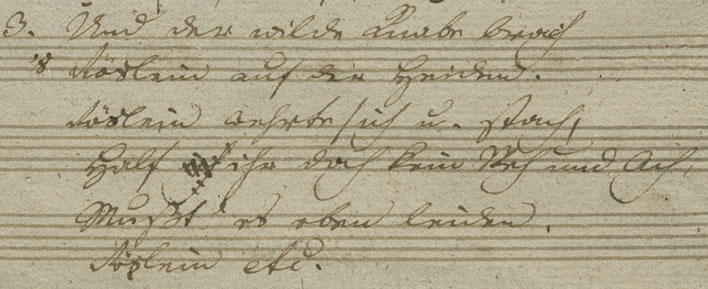
Franz Schubert's manuscript version of verse 3. The manuscript is available online from the Staatsbibliothek zu Berlin – Preußischer Kulturbesitz.
Und ich will's nicht leiden
Und ich will's nicht leiden: the crux of Goethe's poem and the cross on which many translators have dangled helplessly. Firstly, will, a seductive future for English ears – a 'false friend' as it is called in the language-teaching literature – is here in the German sense of 'to want'. It is not a predictive future. It expresses emphatically that the rose does not want to be picked and that she will defend herself as best she can. Her protestations of her sufferings Half ihr doch kein Weh und Ach were, however, of no use against the wild youth.
ihr
Those with English as their mother-tongue will probably not notice ihr at all. For them die Rose is without doubt the leading lady in this drama and for that she is an ihr, 'her'. The German language, in contrast, uses grammatical gender and not natural gender: whether girl, das Mädchen, or the rose diminutive, das Röslein, the grammatical gender is neuter. Helfen, 'to help', requires a dative personal pronoun that corresponds in gender. The pronoun should therefore be ihm, 'it' or 'him', not ihr, her.
Goethe, who knew a thing or two about writing German, of that you can be sure, chose to write ihr not ihm: he chose natural gender over grammatical gender in order to disambiguate the phrase. The grammatically 'correct' ihm could refer to the boy, der Knabe, or the little rose, das Röslein, which would lead to annoying ambiguity about which of the two participants was not helped by the lamentations of Weh und Ach. In short the entire point of the poem would be difficult to work out, as we showed in our comment to the illustration of the 'rape parable' above.

Schubert, the teacher's son and the teaching assistant carefully corrects a mistake [irh?] and writes ihr, thus following Goethe's original intention. Schubert the song composer does not allow Schubert the schoolmaster to correct Goethe's German: a lesson to us all.
The manuscript is available online from the Staatsbibliothek zu Berlin – Preußischer Kulturbesitz.
Nevertheless, know-all editors down the ages have reached for their grammar books and corrected that idiot Goethe's German – if Goethe himself didn't nod, then it must have been the idiot compositor. In doing so they have made the poem much more difficult to understand. Ihr survived in all the editions of Goethe's poetry for nearly 50 years, until the 'correction' made its way into the 40 volume edition: Goethe's Werke. Vollständige Ausgabe letzter Hand, Cotta, 1827-1830. Unfortunately, ihm then became the orthodox reading, even for the otherwise so punctilious Fischer-Dieskau.
Mußte es eben leiden
Mußte es eben leiden, 'just had to suffer it'. This poem has no moral. It is not improving. It could be a story from Ovid's Metamorphoses, a work much admired by Goethe. In Ovid's tales we are in a pre-Christian, pantheistic world, filled with tricky gods who can turn on humans without warning. Human actions have consequences, but those consequences are not what the modern mind, steeped in the Judeo-Christian tradition, would understand as justice.
For example, in Book III of the Metamorphoses, Actaeon accidentally comes across the naked goddess Diana bathing. Because of this violation he is transformed into a stag and ripped to pieces by her hunting dogs. His transgression was accidental. In today's world a good lawyer would get him off without difficulty. In Ovid's Graeco-Roman world, Actaeon's transgession was still a transgression and had to be punished with hard inevitability – he 'just had to suffer it'.
Heidenröslein would fit extremely well into the Metamorphoses– violent, murderous and amoral. Don't look for Christian sense in this poem.
Who wrote Heidenröslein and when?
We simpletons ask simple questions: 'Did Goethe write this poem?' To this we can give a clear and decisive answer: 'Yes and no'.
The poem we reproduced above as Heidenröslein was printed by Goethe in his poem collection from 1789 [Schriften 8:105f]. Goethe oversaw the production of the book so this is indubitably his poem. Which takes care of the 'yes' part of the answer.
The 'no' part of the answer comes when we follow the process of the creation of the poem. There was no void out of which Goethe created Heidenröslein as we receive it in 1789, rather there were a number of predecessor versions which may or may not have had something to do with him. The simpleton's question now is: 'When did Goethe write this poem?'
Goethe in Strasbourg
The scholarly tradition considers Heidenröslein to be one of the so-called Sesenheimer Gedichte, the poems he wrote during his two years or so in Strasbourg (1770-1771). They are Sesenheimer Gedichte not Straßburger Gedichte, because Goethe's love interest during that period was Friederike Brion (1752-1813), one of the daughters of Johann Jakob Brion, the vicar of Sesenheim (now Sessenheim), a village about ten kilometres north of Strasbourg.
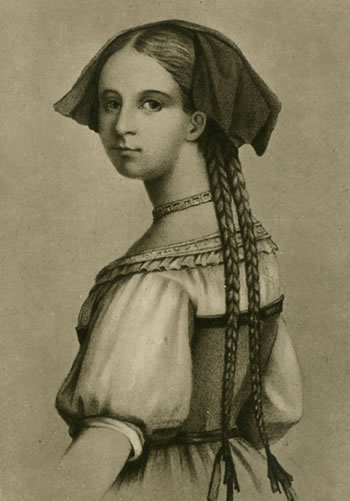
Friederike Brion. ND. F. A. Ackermann's Kunstverlag, München. Serie 146: Goethes Freundinnen. 12 Portraits: Nr. 1755. There is no evidence that this image is derived from an authentic contemporaneous portrait.
The affair between Friederike and Goethe was tumultous: disguises, dances, assignations, thundering horseback rides through the night – quite Mills and Boon, in fact. The vicar's daughter, her heart suddenly set free by this passionate, headstrong, intellectual, 21-year-old poet: Gretchen and Faust, with Mephistopheles whispering into his ear. The prurient can easily imagine bodices being ripped in such circumstances.
As vicars' daughters down the ages have discovered, those wild-eyed poets spurring their horses through the night to moonlit trysts generally turn out to be heartless swine, caring only about themselves. Friederike's very own poet, Goethe, was no different.
After Goethe had completed his studies in Strasbourg he paid her a farewell visit, on 7 August 1771. During the parting they were both in tears, but he prudently stayed on his horse and then rode away. [Dichtung (3:11)537] A week later he left Strasbourg for his home town, Frankfurt.
Friederike was under the impression that they were 'a couple', as we say nowadays, possibly engaged. This point however is uncertain, since Friederike's sister burned all Goethe's letters after Friederike's death. A silly thing to do, because Friederike's revenge on her wild poet would have been complete had subsequent generations been able to read what the cad wrote to her.
Never trust a genius. Friederike assumed the parting would be brief and her dashing poet would be returning soon. Goethe clearly knew all along that for him the parting was for ever. He made this clear to her shortly afterwards in a letter sent from the safe distance of Frankfurt. He received a bitter reply from her that 'tore his heart' [Dichtung (3:12)558]. It may have torn his heart, but it did not change his mind. Even the painful days of that last farewell he 'could no longer remember' when it came to writing an account of them. [Dichtung (3:11)537]
After leaving his vicar's daughter, Goethe would become the genius of the age. He would journey to Italy, to the Alps three times, follow his prince into battle etc. etc. Of women he could take his pick – he tells us that in Rome, while composing verse in his head, he would count its metrical feet with his fingers on the spine of the current woman asleep next to him.
He was not the marrying kind – at least until old age made it palatable. We cannot hold that against him, but the manner of his abandonment of Friederike reflects badly on him. She stayed in Sesenheim and never married, despite having at least one other suitor.
Goethe made a short personal detour to visit Sesenheim in mid-September 1779, eight years after he rode away from Friederike. He was on his second journey to Switzerland in the company of the young Karl August Duke of Weimar (1757-1828), the Duke's Chief Forester, the Duke's butler, his own servant, a hunter and a groom for the horses. The companions' route ran so close to Sesenheim that it would have been strange had Goethe not broken away and taken the short diversion. Goethe received a better welcome than he expected or deserved, as he told Charlotte von Stein, the new passion in his life:
[25 September 1779] In the evening I rode to Sessenheim, aside from our route, whilst the others continued on their way. I found a family together there just as it had been when I left eight years previously. I was received kindly and well. Now that I am myself as clear and still as the air, the breath of good and still people is very welcome. The second daughter of the family once loved me more than I deserved and more than some others to whom I have given passion and loyalty. I had to leave her at a moment that almost cost her her life. She skated over the subject of what still remained of that sickness, and bore herself with so much loving friendship from the first moment. We nearly bumped into each other face to face on the threshold and our noses were side by side in a way that I found to be very pleasant. I have to tell you in retrospect that she never attempted not even with the lightest contact to awake the old feelings in my soul. She led me into the old familiar copse, where we sat. It was all good. We had the most beautiful full moon. I asked her about everything. [...] I found old poems that I had given her, a carriage that I had drawn, we reminisced about some of the things we got up to from those good old times and I found the memory of me still alive amongst them as though I had been gone scarcely half a year. The old folk were kind, they said I seemed to have got younger. I stayed the night and left the following morning at dawn, sent off from friendly faces, so that I could now think of that corner of the world with contentment and at peace with the spirits of the reconciled that can now live in me.
Briefe IV, 4, 849, p. 66f.
Read metaphorically, Heidenröslein seems to be about desire, mutual wounding, pain and one-sided, selfish destruction. That seems to be a pretty good summary of the Goethe-Brion love affair. Possibly.
Therefore, using our old friend circular logic, we can now state that Heidenröslein is one of the Sesenheimer Gedichte that were composed during Goethe's stay in Strasbourg and his dalliance with Friederike.
Therefore, Heidenröslein was probably composed in 1772.
That really is a step too far.
Firstly, there is no documentary evidence for this at all: no scrap of paper, no diary entry, no remark in a letter – not one single hint anywhere. The first time that Goethe's Heidenröslein appears is in his collection of poems in 1789, almost twenty years after Friederike and Strasbourg/Sesenheim.
Secondly, the true bitterness of his separation from Friederike and the full realisation of the immense pain he had caused her only became apparent to him when he received her caustic letter in 1772. He was racked with feelings of guilt, but got over them without noticeable damage. If Heidenröslein was a metaphorical reworking of all that, it could only have been written some time after then.
Predecessors
Once we clear our heads of the assumption that Goethe wrote Heidenröslein in Sesenheim we can look at the poem's development history with an uncluttered mind. German scholars have uncovered a number of variants that were circulating in the 1770s. Apart from a distant ancestor in 1602, these variants are all associated with Johann Gottfried Herder (1744-1803), another of the great names of German literature.
At times like this we need a table. We have given only the first stanza of each poem here, but the full, unhighlighted texts are reproduced at the bottom of this page.
| Year | Author | Source/Title/Stanza 1 |
| 1602 | [anon] Paul von der Aelst, collector |
Sammlung Blumen vnd Außbund Allerhandt Außerlesener, züchtiger Lieder und Rheymen
Sie gleicht wol einem Rosenstock Sie gleicht wol einem Rosenstock, Drumb geliebt sie mir im Hertzen; Sie tregt auch einen rohten Rock, Kan züchtig, freundlich schertzen. Sie blüet wie ein Röselein, Die Bäcklein wie das Mündelein. Liebst du mich, / so lieb ich dich, Rößlein auf der Heyden. |
| 1771 | [anon] Flachsland/Herder, collector |
Das 'Silberne Buch'
Die Blüthe Ein Kinderlied Es sah ein Knab' ein Knöspgen stehn auf seinem liebsten Baume, das Knöspgen war so frisch und schön und blieb stehn es anzusehn und stand in süssem Traume. Knöspgen, Knöspgen frisch und schön Knöspgen auf dem Baume. |
| 1773 | [anon] Herder, collector |
'Auszug aus einem Briefwechsel über Ossian und die Lieder alter Völker' in Von Deutscher Art und Kunst Fabelliedchen Es sah' ein Knab' ein Rößlein stehn Ein Rößlein auf der Heiden. Er sah, es war so frisch und schön Und blieb stehn, es anzusehen Und stand in süssen Freuden. Rößlein, Rößlein, Rößlein rot, Rößlein auf der Heiden! |
| 1779 | [anon] Herder, collector 'Aus der mündlichen Sage'. |
Volkslieder
Röschen auf der Heide Es sah ein Knab ein Röslein stehn, Röslein auf der Haiden: Sah, es war so frisch und schön, Und blieb stehn es anzusehn, Und stand in süssen Freuden: Röslein, Röslein, Röslein roth, Röslein auf der Haiden. |
| 1789 | Goethe |
Schriften, Band 8
Heidenröslein Sah ein Knab' ein Röslein stehn, Röslein auf der Heiden, War so jung und morgenschön, Lief er schnell es nah zu sehn, Sah's mit vielen Freuden. Röslein, Röslein, Röslein roth, Röslein auf der Heiden. |
Our task is to work out how we get from the first row of this table to the last row. Generations of German philologists have tried to do this. They have come up with many hypotheses but no agreement. If you start with the assumption that Goethe wrote Heidenröslein in Strasbourg in 1772 the task is as good as impossible.
Given the lack of success of the intellectual firepower that has so far been directed at this problem, there is no chance that our ponderings here will lead to any satisfactory conclusion. Undiscouraged, we place our trust in St Jude, the patron saint of hopeless causes: if we poke around enough something may turn up – or possibly not.
1 —Sie gleicht wol einem Rosenstock, 1602
The first evidence we have on the rose-boy theme is of a poem from a collection printed in 1602 by Paul von der Aelst. The poem consists of nine eight-line stanzas. The first two of these stanzas are clearly alien, so we can reduce the poem to seven stanzas. Aelst printed the same poem in another position in his collection, but with two different 'alien' stanzas as introduction.
Sie gleicht wol einem Rosenstock
Sie gleicht wol einem Rosenstock,
Drumb geliebt sie mir im Hertzen;
Sie tregt auch einen rohten Rock,
Kan züchtig, freundlich schertzen.
Sie blüet wie ein Röselein,
Die Bäcklein wie das Mündelein.
Liebst du mich, / so lieb ich dich,
Rößlein auf der Heyden.
The simile of girl and rose is explicitly stated in the first line of the first of our seven stanzas. This is, by the way, the only text specimen in which we find the mention of a Rosenstock, a rose bush, as opposed to a solitary rose. The phrase Rößlein auf der Heyden is repeated twelve times in the seven stanzas, usually for the second and last lines.
The rest of the poem is a jumble of actions, ideas – some contradictory – and speakers. It is impossible to extract a consistent or satisfying narrative from these seven stanzas. [Joseph 25] puts this confusion down to the accretions that an orally transmitted folk song acquires in its passage from singer to singer. He bravely goes on to remove the material he considers extraneous in order to arrive at an Urtext, an 'ancestor text', ending up with a reconstruction of a three stanza poem. [Joseph 29f]
The reader will be delighted to hear that for our present purposes we don't need to go into any further details about this poem. Even though the narrative is quite different, if only from the use of the phrase Rößlein auf der Heyden it is not unreasonable to see this poem is some sort of ancestor of Goethe's Heidenröslein, but what sort?
2 —Die Blüthe, 1771
The next station we arrive at in our passage down this via dolorosa occurs in June 1771, nearly 170 years after the printing of Paul von der Aelst's anthology. It is in Das Silberne Buch, 'The Silver Book'.
This is not a printed book but a collection of manuscript pages loosely bound within a wrapper of silver-coloured boards, 115 x 190 mm. Classical scholars would unhesitatingly call it a codex. It contains a collection of poetry put together by Caroline Flachsland, the putative fiancée of Johann Gottfried von Herder (1744-1803). It consists of a total of 198 pages containing around 70 poems transcribed in a fair hand by Caroline. About a third of the poems are by Herder himself, the remaining two-thirds are translations and derivations, also by him. [Spoerhase 59]

From [Spoerhase 72]: Cover of the Silbernes Buch, Berlin, Staatsbibliothek – Preußischer Kulturbesitz, Nachlass Herder, Kapsel XX, 124.
Herder and Caroline met while he was briefly staying in Darmstadt, where she lived. Love was in the air between the two almost from the beginning. When Herder had to leave Darmstadt to travel on to Strasbourg, they managed an hour or so of light (?) petting before he ascended the coach 'in tears and laughter'. [Grimm 4] Their subsequent status as a couple – engaged, half-engaged or just good friends – is unclear. Goethe later decided she was Herder's Halbverlobte, 'half-fiancée' [Dichtung (2:10)439]. Whatever.
From the first letter dated 20 August 1770, which Herder handed to Caroline personally, until the last on 19 April 1773, just before he returned to Darmstadt on 26 April, they were scribbling away to each other. We have 198 letters from this period, 115 from him and 83 from her. [Grimm 5]
At the beginning of 1771 the devoted Caroline made her 'Silbernes Buch', which she gradually filled with high-quality, finely calendered Postpapier. She filled the 'book', almost as an archive, with the poetry contained in Herder's letters to her. The veneration implicit in her use of such fine paper for her lover's works is lambent: she mentions explicitly the quality of paper in a letter on 14 June 1771. Herder, who, as we shall soon see, was quite lacking in emotional intelligence, missed the feminine devotional point completely. He wrote back to her on 22 June fretting at the extravagance – Herder, the Protestant clergyman to his fingertips – and worrying that Caroline was publishing his drafts. [Spoerhase 63]
Herder returned to Darmstadt on 26 April 1773. Engaged or not, it took only six more days before they were standing at the altar, on 2 May 1773. [Grimm 5] Three years of scribbling to each other came to an end.
On page 86 of Caroline's 'Silbernes Buch' she wrote down an unattributed poem, Die Blüthe, 'The Blossom', which is explicitly styled Ein Kinderlied, 'a children's song'. The poem is assumed to be Herder's work, since a letter from Caroline to him at the end of May 1772 implies as much. [Joseph 40]
Die Blüthe
Ein Kinderlied
Es sah ein Knab' ein Knöspgen stehn
auf seinem liebsten Baume,
das Knöspgen war so frisch und schön
und blieb stehn es anzusehn
und stand in süssem Traume.
Knöspgen, Knöspgen frisch und schön
Knöspgen auf dem Baume.
We have no Röslein here, it is true, instead we have a rare diminutive of Knospe, a bud: Knöspgen, a 'budlet', not in an open field but on a tree.
The -gen diminutive has fallen completely out of use nowadays. In the late 18th-century the mannerism was used on occasions. The poet Johann Georg Jacobi (1740-1814), who was held in contempt by many of the great writers of the age – Klopstock, Herder and Lichtenberg – for his anodyne, even sugary poetry aimed largely at the female market, was considered a particular sinner in respect of -gen.
Our sparky readers will remember Jacobi as the author of the verses for Litaney auf das Fest aller Seelen, which Schubert set to music sometime before November 1816. As we noted in that context, singing all the nine verses which Jacobi wrote is a fearsome test of stamina for audience and singer alike.
Georg Christoph Lichtenberg (1742-1799), one of the great mockers of the age, wrote in May 1769 of the Nachtgedankenfeind Jacobi, 'the enemy of reflection Jacobi', who not only liked his diminutives but might replace every -chen with -gen:
Seufzt' jedem Mädgen holde Briefgen
Voll Liebe und Diminutivgen,
Nie alles voll, stets nur ein bisgen
Knosp’ ward ein Knöspgen, Fuß ein Füßgen
[…]
Joost, Ulrich und Albrecht Schöne eds. Georg Christoph Lichtenberg. Briefwechsel. Band I 1765-1779. Verlag C. H. Beck München, 1983. Brief no. 10, 'Göttingen im May 1769', p. 17.
Despite all the later mockery, the -gen diminutive did have its place. One example comes immediately to mind, ein Tröpfgen Wasser (l. 84) in Albrecht von Haller's complex and deadly serious work, Unvolkommene Ode über die Ewigkeit (1743).
Herder himself seems to be using this diminutive without embarrassment or mockery in his 'children's poem' Die Blüthe. If, however, he is using it as a mannered affection just for children he should be ashamed of himself.
[Joseph 42f] speculates that Die Blüthe was the product of Herder's didactic rewriting of Die Rosenknospe, 'The Rosebud', (1769), a poem from a collection of children's poetry by the then renowned but now largely forgotten Christian Felix Weiße (1726-1804). Weiße's poem has nothing whatsoever to recommend it – 'execrable' is probably the kindest description for such literary child abuse. However, if it was the inspiration for Die Blüthe Herder rewrote it totally.
Wherever Die Blüthe might have come from, a glance at our highlights in the first verse will show how many language and structural elements this poem has in common with later versions, particularly the marked structure of the last two lines of each stanza. In terms of structure, the jump to Goethe's masterpiece of 1789 is not a great one.
As far as the content is concerned there is little in common with its presumed successors. In the narrative of Die Blüthe we detect the moralising hand of Herder, the clergyman. The moral of Herder's poem is a bizarre and confusing message about delayed gratification, devoid of all sexual applications: if you pluck the flower now there won't be any fruit to pluck later.
The reason that Herder changed the flower in the poem from rose to tree blossom now becomes clear, as the following photo demonstrates:
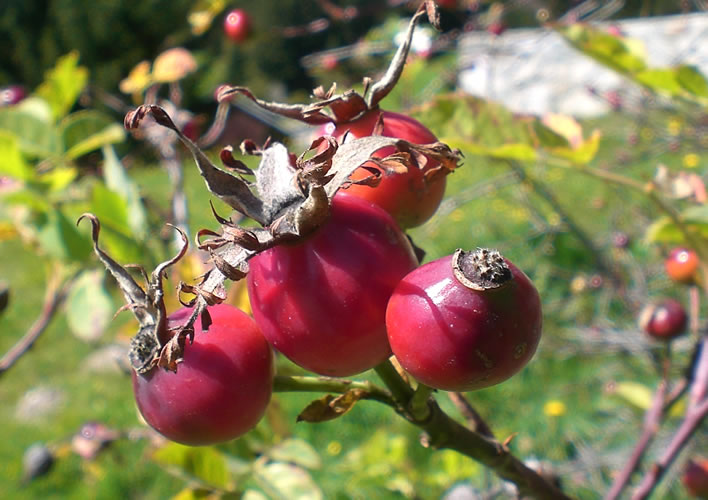
Die Blüthe, of course, is referring to tree-blossom and the fruit that follows it, such as apples or cherries. If that is the moral Herder is aiming at, then roses are no longer suitable flowers. The rose brings us rose-hips, which, unlike apples, are not things you would want to eat directly, so inedibly bitter are they. They are indeed a traditional food and herbal remedy – once enough water and sugar has been added. Image: ©FoS.
Which, in turn, suggests strongly that Herder, still absorbed with writing improving poetry for children, came up with the moral first and then adapted the existing Röslein structure for his task. What a contrast with Goethe's amoral, Ovidian Heidenröslein nearly 20 years later, which was definitely not written by a pastor!
3 —Fabelliedchen, 1773
In 1773 Herder, as part of a discussion of the Volkslied, 'folk song', gives us an example which he titles Fabelliedchen, 'fable song'. He states that he is writing this poem down from memory.
Fabelliedchen
Es sah' ein Knab' ein Rößlein stehn
Ein Rößlein auf der Heiden.
Er sah, es war so frisch und schön
Und blieb stehn, es anzusehen
Und stand in süssen Freuden.
Rößlein, Rößlein, Rößlein rot,
Rößlein auf der Heiden!
The structural and language similarities of Herder's Fabelliedchen and Goethe's Heidenröslein are striking.
Herder has not only returned from Knöspgen to Röslein, he has changed the moral of the tale. In fact, there is now no moral, just a trite observation from Pastor Herder that the pain was all worthwhile: 'The rose defended itself and pricked. But he [the boy] forgot the pain in the later enjoyment!' We expect better of a poem that calls itself a fable.
With Herder's Fabelliedchen we are remarkably close to Goethe's Heidenröslein, with the exception of the weak conclusion. Those who want to verify this in detail can consult the full German texts for all these variants in the supplement below.
We wonder at Herder's state of mind, when we read his introduction to this piece:
[…] In our times there is so much talked about songs for children: would you like to hear an older German? It contains no transcendent wisdom or morality, with which children at the moment are inundated – it is nothing but a childish 'Fabelliedchen'.
'Is that not a childish tone', he asks. In his comments on the nature of this poem as a Volkslied Herder acknowledges that he has improved the childish poem in a way that can profitably be used on most poetry of this genre: the elision of unimportant words. In the German that existed before the grammarians got to it this was easy, by Herder's time just writing Röslein without an article was unacceptable in most situations. His proposal was to replace articles with apostrophes: ' Röslein for das Röslein.
Herder also pointed out a corollary of this problem, that it was difficult to have metrical schemes that matched the realities of the text. Let us leave that uncommented at the moment: it is a developing story. We just note that at no point does Herder remark that he is editing a poem written by Goethe. The reason: he wasn't.
4 —Röschen auf der Heide, 1779
In 1779 Herder published this 'childish' poem in a collection he called Volkslieder, 'folk poems'. It is entitled Röschen auf der Heide, which is a puzzle in itself, in that throughout the poem we hear only of Röslein. It is subtitled Deutsch and a note at the end of the book tells us that it is aus der mündlichen Sage, 'from the oral tradition' – there is definitely no mention of Goethe.
Röschen auf der Heide
Es sah ein Knab ein Röslein stehn,
Röslein auf der Haiden:
Sah, es war so frisch und schön,
Und blieb stehn es anzusehn,
Und stand in süssen Freuden:
Röslein, Röslein, Röslein roth,
Röslein auf der Haiden.
The poem is very similar to his Fabelliedchen from six years earlier, the main difference is in some grammatical changes that he has made to implement his own precept of trying to write without articles. As a result, the metrical car crash that started in Fabelliedchen has become a full-blown motorway pile-up.
The moral of the poem remains the same as it was in its predecessor: [the boy] forgot the pain in the later enjoyment.
5 —Heidenröslein, 1789
The sequence of the three Herder poems reveals a poet messing about trying to write a pretend Volkslied. We can say with absolute, rock-solid certainty, that Goethe had nothing whatsoever to do with these. We cannot prove that Goethe did not declaim some oral forerunner to Herder, who then misremembered it and mangled it on several occasions, but it seems unlikely. None of the tricks that memory plays on us can account for Herder's mutilations.
All these experiments in Volkslieder are simply not good enough to be Goethe's work or to be based on his work. They are not descendents of Goethe's poem, they are ancestors.
Furthermore, since Herder never claimed these mutants to be his, but rather did everything possible to camouflage them as belonging to an oral tradition despite all the evidence of his editorial manipulations, Goethe cannot be criticised for taking these half-baked disasters and showing everyone what a poetic master can do.
Heidenröslein
Sah ein Knab' ein Röslein stehn,
Röslein auf der Heiden,
War so jung und morgenschön,
Lief er schnell es nah zu sehn,
Sah's mit vielen Freuden.
Röslein, Röslein, Röslein roth,
Röslein auf der Heiden.
The content of Goethe's Heidenröslein my seem superficially very similar to that of Herder's Röschen auf der Heide, but properly considered the two poems are far apart. Herder's effort is a half-hearted manipulation of trite images brought to a half-hearted conclusion, its unimaginative incompetences excused as a Volkslied for dimwits or a children's fable for ten-year-olds.
In contrast, as we have already suggested, Goethe's poem is an evocation of the pantheistic classical world using contemporary terminology. This is no Volkslied, but a grown-up poem for grown ups. The Graeco-Roman world of magical transformations had passed, but the world of arbitrary suffering was still present.
On 1 November 1755, an earthquake struck Lisbon and brought arbitrary death to up to a hundred thousand people. On All Saints' Day, of all days! The search for explanation or justification occupied the greatest minds of the age for the remainder of the century and the event became one of the pivotal moments of the Enlightenment. Goethe was five at the time. He described the intellectual impact of the event in his autobiography:
God, the creator and sustainer of Heaven and Earth, wise and merciful, as the first article of the Credo described him, had not shown himself to be in the least bit fatherly, in that he had he allowed the righteous and the unrighteous to meet the same destruction. [My] young spirit tried in vain to reject these impressions, a task which turned out to be even more impossible given that the wise and the learned could not themselves agree how such a phenomenon should be viewed.
Dichtung (1:1)32
The death of the Heidenröslein is quite arbitrary. She was seen by chance by a youth and was killed by him, despite her saying Und ich will's nicht leiden, 'I don't want to suffer it' and despite her thorny defences. She was ultimately powerless against him and she went unrevenged: she Mußte es eben leiden: just had to accept her fate.
Surface and symbol
We have already feminised the rose by calling 'her' a 'she'. In doing this we have gone beyond gender assignment and are now trembling on the brink of the 'pathetic fallacy'. Only two things can save us from the abyss.
The first possibility is metaphor. The boy remains a boy, with all his wildness, but when we say rose we 'really' mean a girl. We noted how the putative ancestor-poem from 1602 introduced a simile between girl and rose, right in its first line: 'she was like a rosebush', but in the jumbled verses that follow nothing more is made of this.
In Herder's Die Blüthe there is no metaphorical content at all. In his two other efforts, Fabelliedchen and Röschen auf der Heide, the moralising conclusion alone rules out that there were any metaphorical thoughts in Pastor Herder's head. Goethe's Heidenröslein may, at a stretch, be read as a metaphor for his relationship with Friederike Brion, but, apart from a talking rose, there is really no prompt in Goethe's text that leads us to the rose-girl metaphor.
But despite this lack of textual authority for them, the metaphorical readings seem to be dominant – at least in the common mind. How can we make this completely unfounded assertion? In the same way that we used the collection of Heidenröslein postcards above to show how confused readers of the poem were about the important term Heide.
All but two of our illustrators place a female figure in or around the rosebush. It is she who is the object of desire for the young man, not the rose. Ditto in the 'rape parable' illustration we presented (go on, you remember it, the hot shepherdess chick in the off-the-shoulder number about to stick it to some wimp – Lara Croft, no?). In contrast, the two heroic deviants who just show us a rosebush and a young man admiring it are reading the surface of the poem and not grasping at the metaphor.
The second possiblity that can save us is the application of one of this blog's most valuable sayings: 'Read the words on the page, not the thoughts in your head'. For this beloved metaphor is actually not there at all – not in Goethe's poem, not in Herder's clerical bumblings, not even in the 1602 ancestor.
'What about the talking rose?', you ask. Well, Goethe's pantheism takes care of that in fine style, just as his value-free Ovidian mind takes care of the brutal dénoument: Mußte es eben leiden, 'just had to suffer it', the same detached tone that is found throughout the Metamorphoses. There are no major metaphors or allegories in the Metamorphoses, it is all surface: at times the everyday world is that surface, at times the divine world breaks through. In reading the Metamorphoses, one of his most loved books, Goethe has left the rococo allegories of his peers and gone back to the Graeco-Roman surface.
In Goethe's tale there are no ethics of any kind, either Christian or 'Natural Justice'. The manual describing such godly arbitrariness is not Herder's Christian Bible, it is Goethe's Ovidian Metamorphoses. The interplay of the two is reflected in the relationship of the two men between the time of the writing of Herder's Die Blüthe and Goethe's Heidenröslein, to which relationship we shall now turn.
Goethe and Herder
Given the interconnectedness of these last four texts we should spend some time looking at the relationship between their authors, Goethe and Herder. On individual, unconnected odysseys, they both happened to be washed up in Strasbourg in 1770-71.
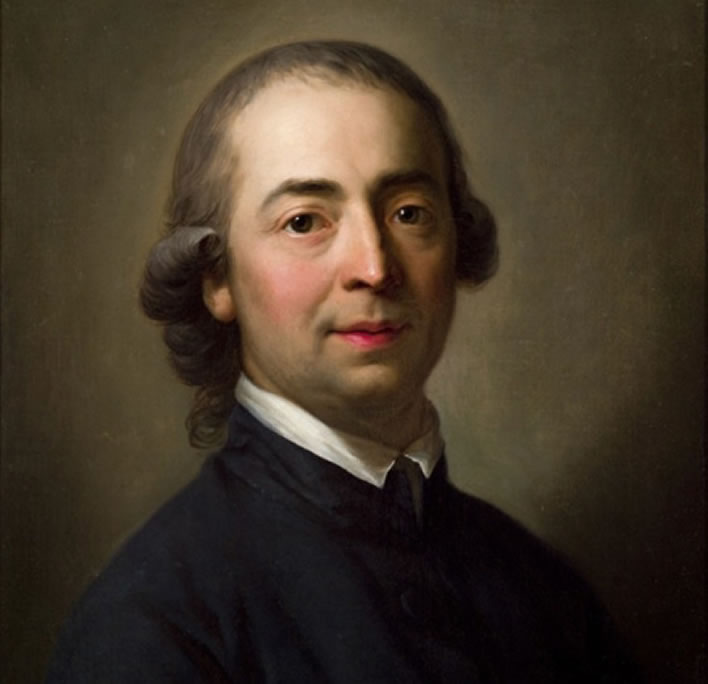
A portrait of Johann Gottfried Herder by Anton Graff (1736-1813), c. 1775. Image: Gleimhaus Halberstadt, Porträtsammlung Freundschaftstempel. Online.
Herder was in a small dinghy marked 'travel preacher' in the tow of the 15-year-old Prince Peter Friedrich Wilhelm von Holstein-Gottorp, later Duke of Oldenburg (1754-1823). The young man suffered from mental illness, seemingly some kind of depression; it is difficult to see how the dark presence of Herder would bring cheer to anyone in that state. The princely retinue had departed from Eutin in the far north of Germany in July 1770, dropped anchor in Hannover, Kassel, Göttingen, Darmstadt and Mannheim, finally beaching in Strasbourg, where in October Herder cast off the towrope from his noble teenager so that he could remain in Strasbourg to get his eye complaint treated by Dr Lobstein.
On that odyssey the princeling's mental state had got worse, so that separating the depressed youth from the sardonic Herder was probably for the best. Herder remained in Strasbourg until April 1771.
Goethe was in Strasbourg to study for a Law doctorate and was also intending to improve his French.
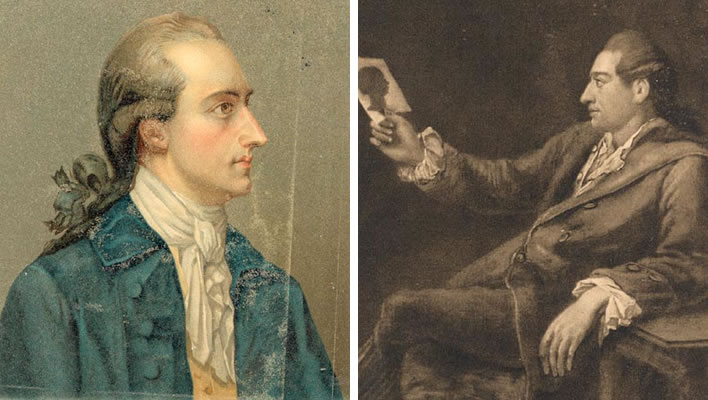
The two images we have of Goethe that are closest to his Strasbourg years.
Left: Goethe in 1778, eight years after leaving Strasbourg. The picture is a coloured copy by Prof. Eberhard Ege (1868-1932) of an original by Georg Oswald May (1738-1816) painted in 1779.
Right: Goethe with a silhouette, painted by Georg Melchior Kraus (1737-1806) in 1775-76, c. four years after leaving Strasbourg.
Images: Goethezeitportal.
Unlike the teenage prince, Goethe could cope with Herder's dark side, considering it worth the benefits of learning and the new horizons that the older man (five years), well-travelled and well-connected in literary circles could bring him.
Goethe dedicated 14 pages of his autobiography to that half-year with Herder in Strasbourg. Despite Goethe's attempt at a measured tone and the frequent allowances he makes for the effects on Herder of the extremely painful, expensive and ultimately fruitless operations on his eye that he underwent, the frequent outbreaks of annoyance at the underlying sarcasm and bitterness of Herder's character demonstrate that it was not a friendship.
Whereas Goethe's year in Strasbourg was all conviviality, romance, adventure and the extension of intellectual horizons, Herder's time was mostly taken up with a series of expensive medical tortures.
The treatment – butchery – on the tear duct of Herder's right eye started in mid-October 1770. Herder thought that even if the operation did no good, it would at least not do any harm. He was wrong. There is a reason that the term 'second opinion' was invented for the medical profession.
The tear duct in Herder's right eye was missing or blocked, meaning that a passage was opened from his nose to allow his tear gland to drain as it should. It took Lobstein three attempts to hit the spot, the first time he used so much force that he broke his instrument. Only at the fourth attempt, with the help of another doctor, did he manage to create the passage. [Caroline 157f]
Herder had to live for six days with a metal rod in his nose to keep the passage open – he would keep it as a souvenir. The external wound was now two inches long. Twice a day a horsehair was inserted and pulled back and forth to keep the passage open. Goethe repeatedly expresses his admiration at Herder's fortitude during these weeks of torture. [Dichtung (2:10)432]
Another operation took place at the end of November; Herder began December expecting his full recovery soon, but by the following spring his hopes were gone. All the treatments had failed and his situation was 'worse than before'. [Caroline 167f]
Herder was grateful to Goethe for his support and companionship during the six months he was confined to his room and during the progress of the operations. Goethe would watch and take a technical interest in the details of the operations, popping in two or three times a day to view the progress of the patient. Whether this was a manifestation of Goethe's love for his fellow man or just a slightly creepy result of his scientific curiosity – well, who can know that? Possibly a bit of both.
Goethe was initially attracted to Herder, but soon discovered his darker side: empathy was not Herder's strong point. Goethe tells us that he himself was a very trusting nature who gabbled to others without reserve. On one occasion, he says, he gabbled away to Herder about his youthful pursuits, in particular a collection of letter-seals he had built up and arranged according to the feudal position of their owners. Herder not only expressed contempt for Goethe's youthful hobby but made him an object of ridicule, even someone to be pitied.
After once more making allowances for Herder's suffering as the cause of his 'contrary, bitter and biting nature' Goethe explores the relationship more deeply:
He was five years older than I, which in youth makes a big difference. Because I recognised him for what he was, that I valued that which he had already achieved, he should have acquired a great superiority over me. But the situation was not pleasant: the older people I had met until then had educated me with gentleness and consideration, perhaps with indulgence even. From Herder, in contrast, one could never expect approval, irrespective of what one did.
Herder wrote an essay for a prize competition on 'The Origin of Languages'. He showed it to Goethe for comment. Goethe praised it, but was foolish enough not to agree with it on every point:
I showed the author my approval, in that I only picked out a few points for comment from my perspective. Each one was met by Herder in the same way: I was chided and criticised. I was only allowed to agree, either conditionally or fully.
For Goethe his relationship with Herder was also a positive experience:
I got to know poetry from a completely different side and in a completely different sense that appealed to me greatly. […] Folk poetry, the traditions of which in Alsace he inspired us to search out, the oldest documents of poetry, that serve as evidence that poetry is a gift of the world and its peoples and not just a private inheritance of a few fine, educated men.
As we have seen, Herder's medical treatments went on and on, without any success, leaving his wallet nearly empty and his face disfigured. He had met Maria Caroline Flachsland in Darmstadt on his princely odyssey – he was, as Goethe put it, half-engaged to her and now wanted nothing more than to flee Strasbourg, this place of torture, and get back to her side. Goethe borrowed some money on his behalf and was irritated by the tardiness of Herder's repayment.
Caroline herself met Goethe in Darmstadt at the beginning of March 1772. Goethe and Caroline hit it off and she reported all their happy doings to her distant half-fiancé, Herder, using that cheerful innocence that people down the ages have used to incite raging jealousy in their partners. At this time Herder, short of money, was having a difficult time as the court preacher in Bückeburg, 300 km to the north of Darmstadt. He replied to her letter in the measured tones of a clergyman in inner torment:
Goethe is really a good man, just a little frivolous and sparrow-like [Spazzenmässig], about which he received my constant reproaches. He was the only one who visited me during my confinement in Strasbourg and whom I saw with pleasure. I also believe, without vanity, to have given him some good impressions, which one day may bear fruit.
Herder to Flachsland, 21 March 1772. [Caroline 218]
A month later Goethe was with Caroline again. He had walked the six hours from Frankurt to Darmstadt, ostensibly to visit his friend Merck. She sent off another letter to Herder describing their frolics, for they met up every day and once, together in the woods, soaked to the skin by a sudden shower, they became 'very confidential' with each other. Goethe told her of his first love, who had misled him for a year, but seemingly nothing of the recently dumped Friederike – the cad! In contrast, poor Herder, Caroline's 'half-fiancée', is still writing to her using the formal Sie style of address.
Despite all Goethe's attempts to make allowances for the nasty side of Herder's nature and Herder's Christian straining to overlook Goethe's trifling with his not-yet-married treasure, the two inevitably drifted apart. Goethe, the happy gabbler, learned to practise reticence towards his mentor. Herder, the Protestant cleric, had so devastatingly criticised one of Goethe's favourite books, Ovid's Metamorphoses, that he had almost ruined Goethe's appreciation of it: 'any liking is difficult to uphold against the denunciations of people you respect.' Goethe kept quiet from now on about all his own projects. [Dichtung (2:10)442]
We have already seen how Heidenröslein would make a good Ovidian tale: an interesting situation described in the clear morning light of the Greaco-Roman world, a pantheistic dialogue between a boy and a rose, violent action, deadly consequences but no moral takeaway. Goethe, the admirer of the Metamorphoses, has created an Ovidian response to its detractor, Herder, using Herder's own imagery and phrasing. Genius!
We are not surprised that the relationship between the two men after the Strasbourg year became patchy. Goethe helped Herder establish himself in Weimar. Herder's book Volkslieder, in which we find his Röschen auf der Heide was published there. A further break came in 1789, caused by the outbreak of the French Revolution. Herder, at heart a Jacobin, supported the French and what they were doing while Goethe, the collector of aristocratic letter-seals, was repelled by it.
1789, that year of revolution, the year the European world changed for ever, was the year Goethe published his Schriften, containing his Heidenröslein. He was around forty years-old, at the height of his powers and had been ennobled in 1782. It took Herder, Goethe's senior by five years, until 1802 before he could add 'von' to his name. He died barely a year later. At that point, Goethe had almost another thirty years to polish his fame.
Conclusion
Goethe's Heidenröslein is what it is. For once, this trite and foolish statement is not too fatuous.
If our boy-soprano wants to have poor Friederike in his mind when gurning his way through the song, so be it. The conclusion of the song is therefore a heartless and amoral 'suck it up' that quite matches the heartlessness of his departure from her. The old ladies in the front row would not understand the performer's sneer, however.
Perhaps our musical youngster might prefer to project a pantheist, amoral, Ovidian tone in his performance. That would be not a hundred miles from his own quizzical position at that time, a position that a brief spell later as a Sunday School teacher did nothing to change. Unfortunately, the unenlightened old ladies on the front row of the concert would probably misunderstand the shrug of the shoulders at the last lines of the song.
Our young singer is probably wise to sing the song straight down the middle, in a rather pensive way, hoping that someone in the audience has read this blog post.
Performances

An 1816 manuscript of Schubert's partitur for Heidenröslein. Click on the image here to open the full size image in a new browser tab. The manuscript is available online from the Staatsbibliothek zu Berlin – Preußischer Kulturbesitz.
So far we have assumed that the musical setting of Heidenröslein is that by Franz Schubert. Among German speakers, however, there will readers who have been shouting the name Heinrich Werner (1800-1833) at their monitors. He was a German Lied-composer, a near-contemporary of Schubert who also died young, whose modern claim to fame from his brief career is an 1829 setting of Heidenröslein as a 'real' Volkslied.
The pan-Germanic Volksmusik community is large and knows what it likes. Schubert fans will have their arrogance dented by a simple YouTube search for Heidenröslein: Werner is numerically very popular indeed. Humbling, too, is the thought that many(?) of the senders, recipients and collectors of the postcards we illustrated would probably have had Werner's setting in mind, not Schuberts: the music shown on the card on the right in the first row is Werner's tune, not Schubert's. The smoothness of his dirge-like setting will surprise the Schubert fans, who are used to the springing trochees – and probably the Goethe fans, too, come to think of it.
Heinrich Werner. Sah ein Knab' ein Röslein stehn: Comedian Harmonists, 1932.
Franz Schubert. Heidenröslein: Dietrich Fischer-Dieskau, Gerald Moore, ND.
Text collection
Sie gleicht wol einem Rosenstock, 1602
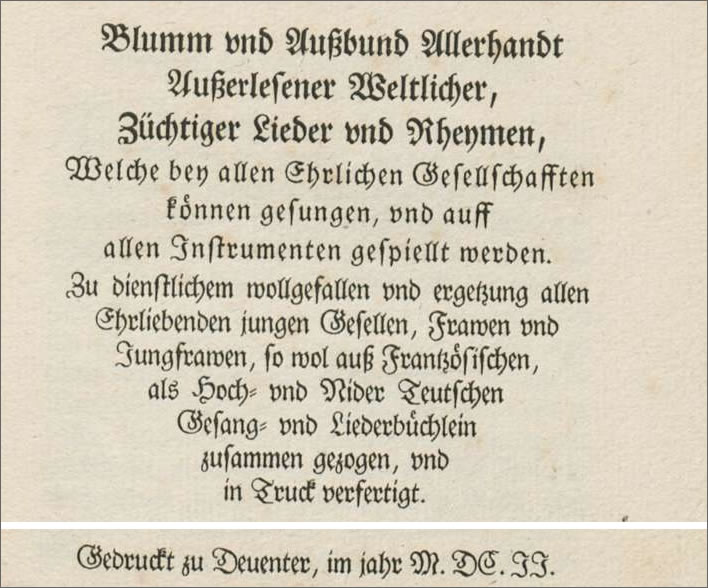
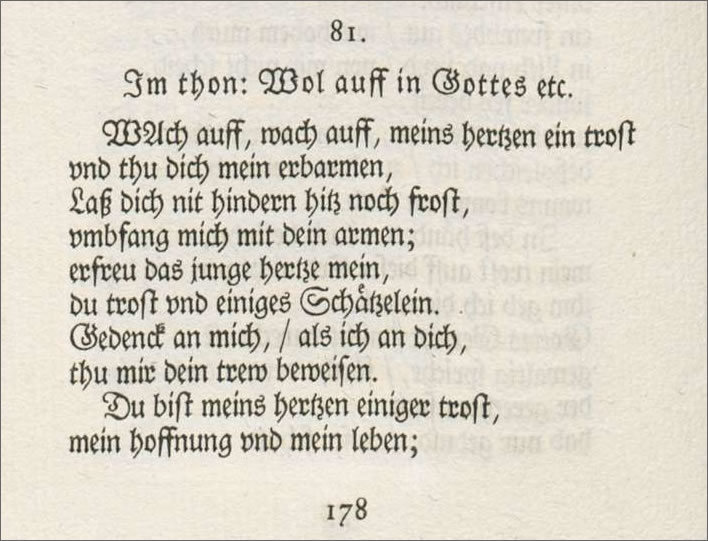
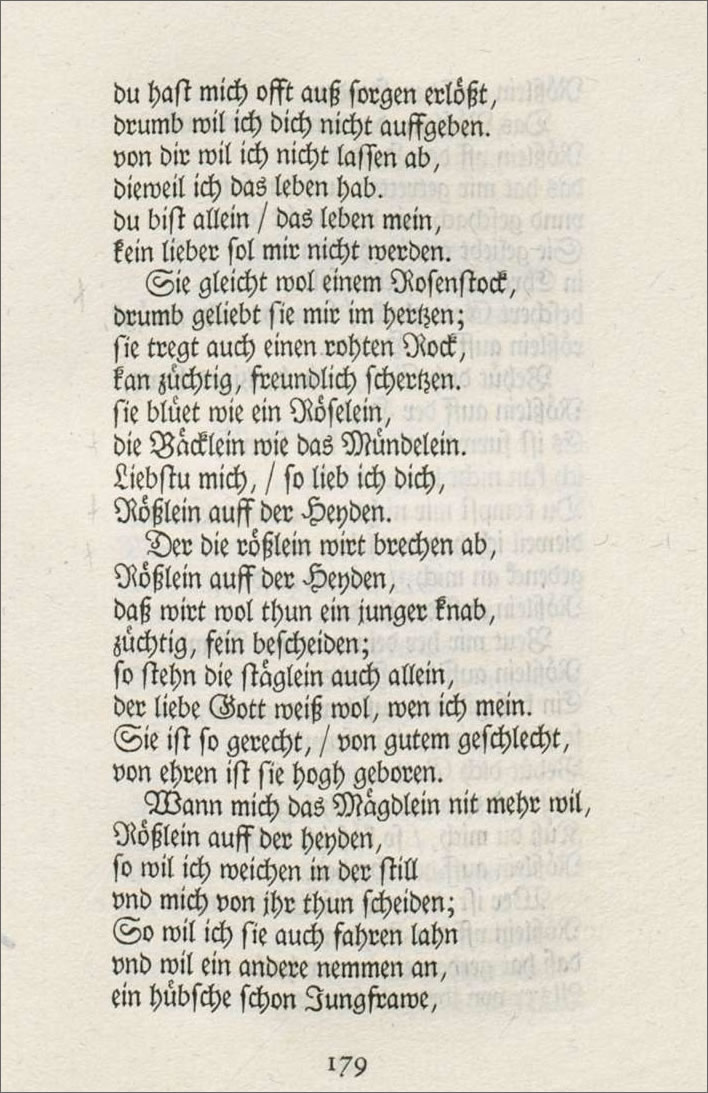
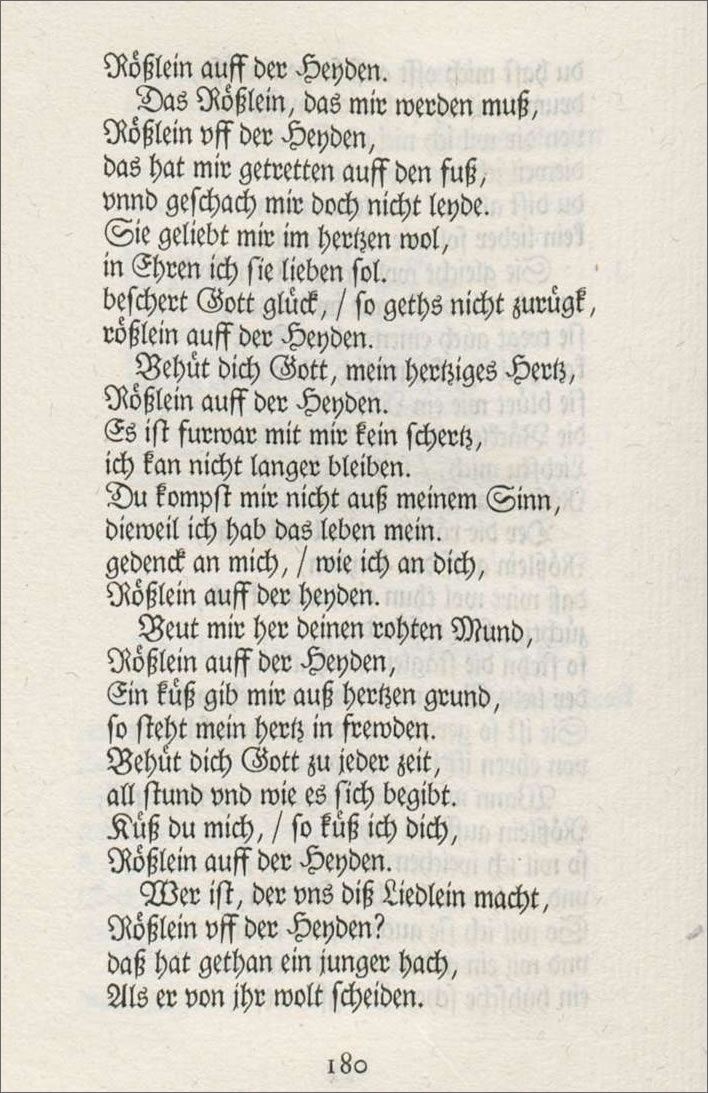
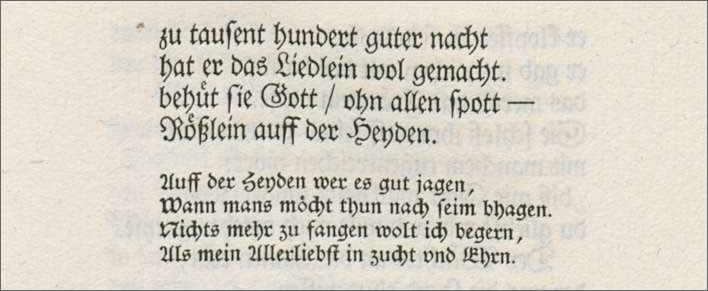
Aelst, Paul von der. ed. Blumm und Außbund Allerhandt Außerlesener Weltlicher, Züchtiger Lieder und Rheymen […], Deventer, 1602. Replicate edition ed. Ernst Schulte-Strathaus, Hyperion-Verlag, München, 1912, p. 178-181. Online source
Paul von der Aelst's Sie gleicht wol einem Rosenstock actually begins with two stanzas that are unconnected with the remainder of the poem.
Johann Ludwig Uhland, in his four-volume collection of folk-poetry from 1844, Alte hoch- und niederdeutsche Volkslieder, reproduces the poem under the title Heideröslein (no. 56), strips these first two stanzas away. He reproduces the remaining seven stanzas from Aelst with sporadically modernised orthography. He also adds a note about some earlier sources. [Uhland 111-113]
He also includes three stanzas of the poem in his essay 'Abhandlung über die deutschen Volkslieder'. [Abhandlung 3:449] In the same essay the reader will find many allusions to poetic roses.
Sie gleicht wol einem Rosenstock is not the only poem in Aelst's collection containing allusions to roses/flowers and Heiden: enthusiasts might want to look at Die schöne Sommerzeit and Groß Lieb hat mich umbfangen.
Die Blüthe, 1771
Die Blüthe
Ein KinderliedEs sah ein Knab' ein Knöspgen stehn
auf seinem liebsten Baume,
das Knöspgen war so frisch und schön
und blieb stehn es anzusehn
und stand in süssem Traume.
Knöspgen, Knöspgen frisch und schön
Knöspgen auf dem Baume.Der Knabe sprach: ich breche dich
du Knöspgen süsser Düfte,
Das Knöspgen bat: Verschone mich
denn sonst bald verwelke ich
und geb dir nimmer Früchte
Knabe, Knabe laß es stehn
das Knöspgen süsser Düfte.Jedoch der wilde Knabe brach
die Blüthe von dem Baume,
Das Blüthchen starb so schnell darnach.
Aber alle Frucht gebrach
ihm auf seinem Baume.
Traurig, traurig sucht' er nach
Und fand nichts auf dem Baume.Brich nicht o Knabe nicht zu früh
die Hoffnung süsser Blüthe.
Denn bald ach bald verwelket sie
und dann siehst du nirgends nie
die Frucht von deiner Blüthe.
Traurig, traurig suchst du sie
zu spät, so Frucht als Blüthe.
Text in Wolff 436f.
Fabelliedchen, 1773
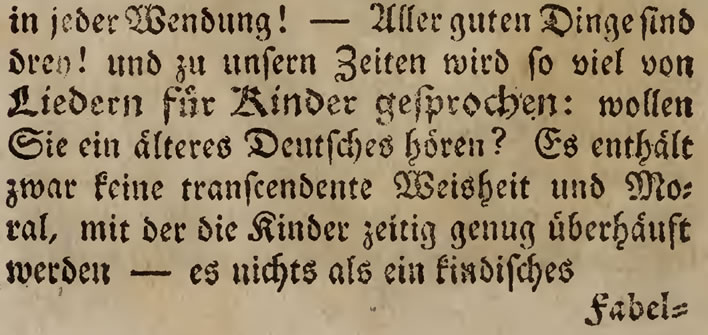
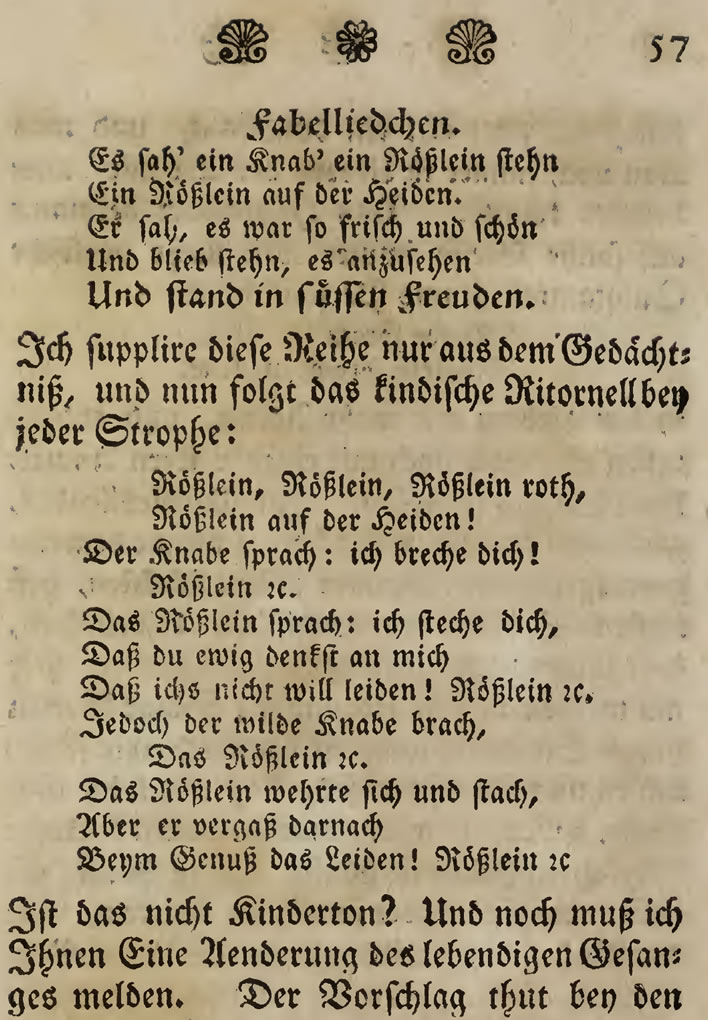
Herder, Johann Gottfried. 'Auszug aus einem Briefwechsel über Ossian und die Lieder alter Völker' in Von Deutscher Art und Kunst. Einige fliegende Blätter., Hamburg 1773. Bey Bode. p. 56f.
Röschen auf der Heide, 1779
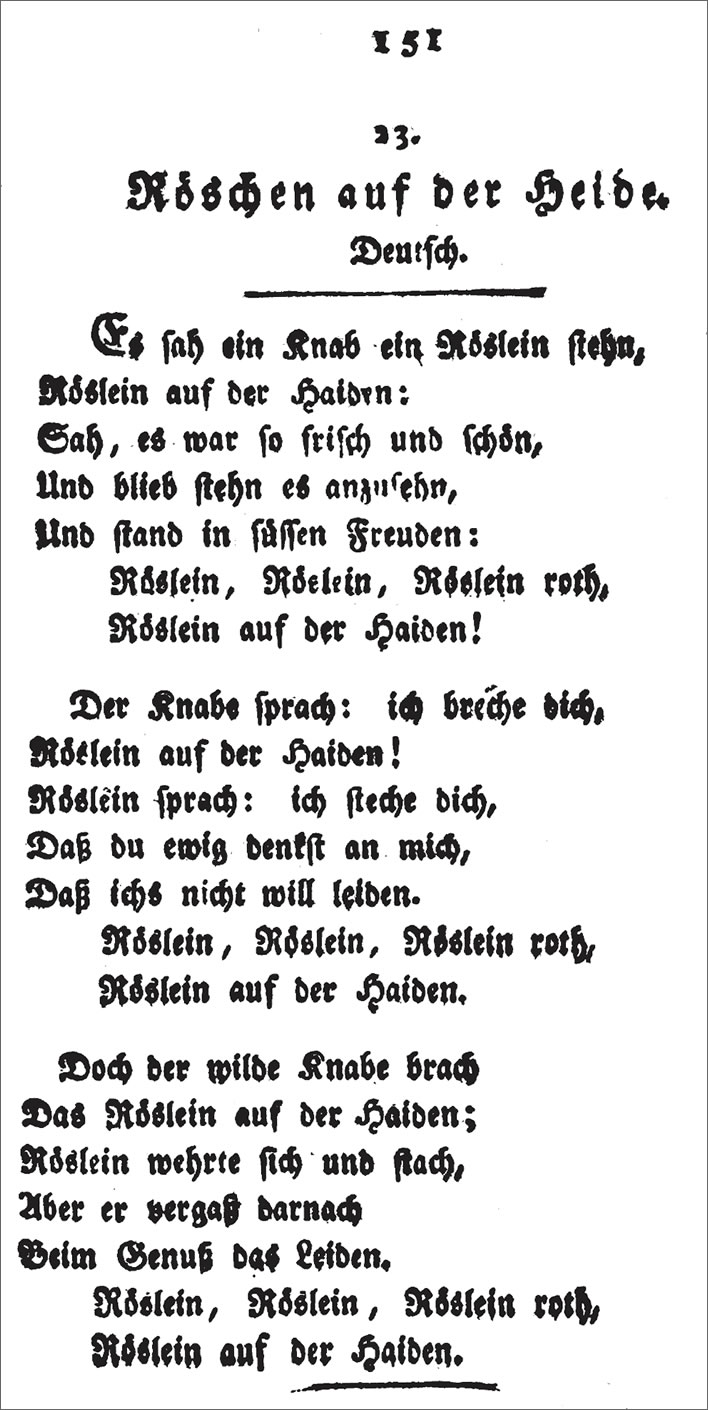
Herder, Johann Gottfried. Volkslieder, Zweiter Theil, Leipzig 1779. In der Weygandschen Buchhandlung. p. 151.
Note, p.307: Aus der mündlichen Sage.
Heidenröslein, 1789
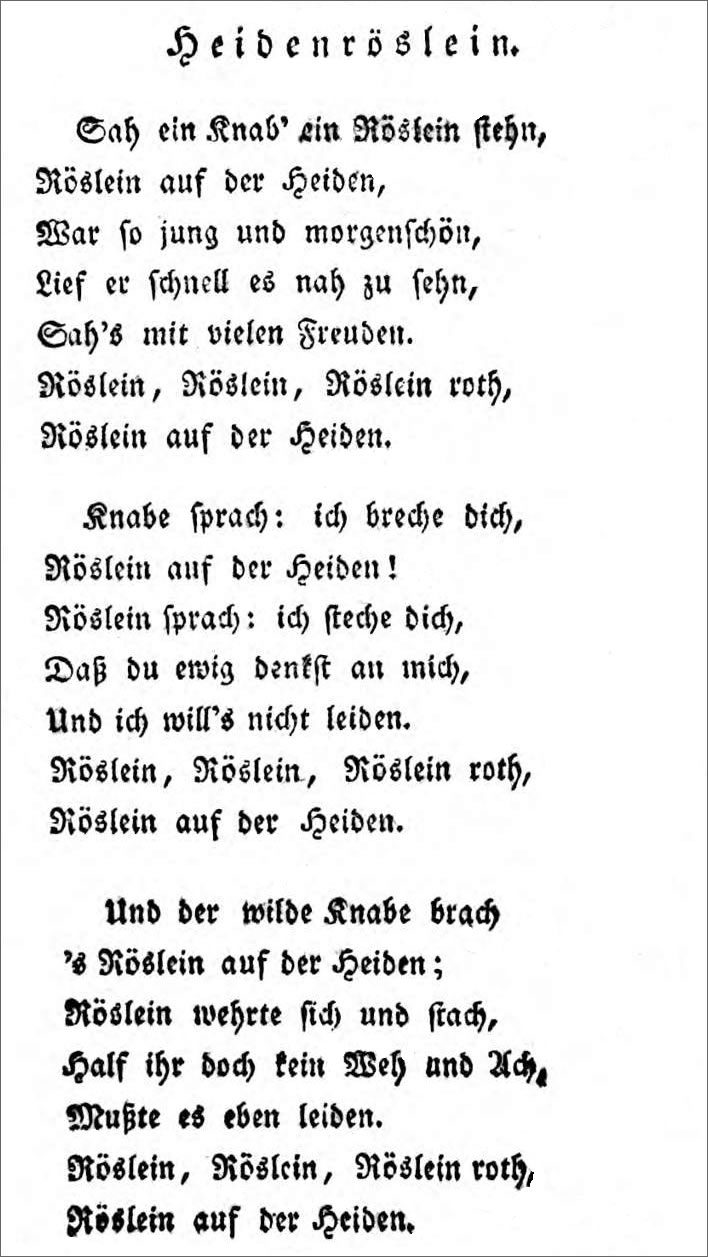
Goethe, Johann Wolfgang von. Schriften, Leipzig, Georg Joachim Göschen, 1789, Band 8, p. 105f. [NB: the layout has been compacted a little.]
Sources
All sources are in German, unless otherwise noted. All translations ©FoS.
| Abhandlung | Uhland, Ludwig; Holland, Wilhelm Ludwig. Uhlands Schriften zur Geschichte der Dichtung und Sage Stuttgart, Verlag Cotta, 1866. Online. |
| Briefe | Goethe, Johann Wolfgang von. Goethe's WerkeWeimarer Ausgabe, IV. Abteilung, Bd. 4, Hermann Böhlau, Weimar, 1889. Online. |
| Caroline | Herder, Caroline von, (Flachsland) Erinnerungen aus dem Leben Joh. Gottfrieds von Herder, Tübingen, Verlag Cotta, 1820, Theil 1. Online. |
| Dichtung | Goethe, Johann Wolfgang von, and Walter Hettche. Aus meinem Leben. Dichtung und Wahrheit, 'From my Life. Invention and Truth' (c. 1811–1833). Durchges. und bibliogr. erg. Ausg. Stuttgart: Reclam, 2012. |
| Grimm | Grimm, Gunter E. 'Halb zog sie ihn, halb sank er hin'. Lektüre im Briefwechsel zwischen Johann Gottfried Herder und Caroline Flachsland. In: Goethezeitportal [PDF download] 2017. |
| Joseph | Joseph, Eugen. Das Heidenröslein, Berlin, Gebrüder Paetel, 1897. |
| Schriften | Goethe, Johann Wolfgang von. Goethe's Schriften, Band 8, Verlag Göschen, Leipzig, 1789. Online. |
| Spoerhase | Spoerhase, Carlos. 'Das Silberne Buch: Heft, Mappe, Buch? Über eine handschriftliche Lyriksammlung von Caroline Flachsland und Johann Gottfried Herder'. Archiv für Geschichte des Buchwesens, Heft 69, 2014, Walter de Gruyter GmbH, p. 59-76. |
| Staffeldt | Staffeldt, Sven. 'Knabe, Röslein, Vergewaltigung. Wo bleibt nur der Diskurs?' Zeitschrift für Semiotik, Band 35, Heft 3-4, 2013, p. 517-552. |
| Uhland | Uhland, Ludwig. Alte hoch- und niederdeutsche Volkslieder : mit Abhandlung und Anmerkungen Stuttgart, Verlag Cotta, 1844, 5 Bücher. Online. |
| Wolff | Wolff, Eugen. Der junge Goethe, Oldenburg und Leipzig, Hof-Buchdruckerei, 1900. |
Update 03.06.2017
Integrated images of a Schubert manuscript of Heidenröslein at various points in the text together with some trivial changes made necessary by these additions.
Update 13.06.2017
Some ramblings that were cut out of the original of this article, on the subject of the postcard illustrations.
Some of the postcards are particularly striking for a number of reasons. This one, for example:
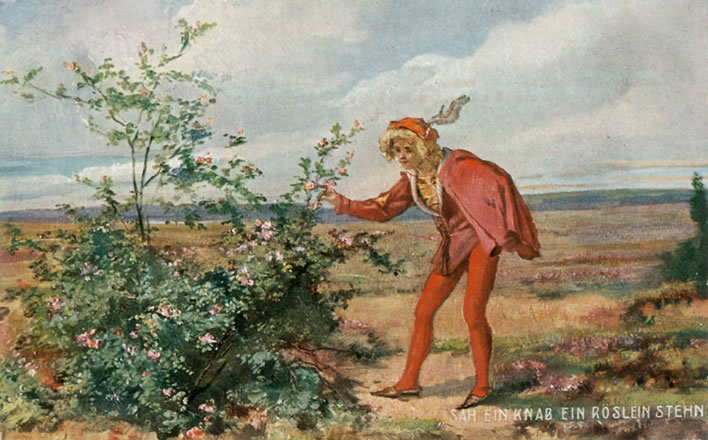
Firstly, we see that the artist has taken Heide(n) in its modern sense, which we characterised using Shakespeare's term as a 'blasted heath'. As heaths go, this one can certainly be called blasted. Refreshingly, no shepherdess is having to hang around in this wilderness.
Secondly, the artist has reached back to one of the earliest uses of the word Knabe, to that of a young man in feudal service in a noble court, specifically a Hofknabe. Both German and English have a number of words for this creature, English examples being 'knave', squire, even 'page'. The latter recalls the photo of Jacques Austerlitz, the eponymous hero of W.G. Sebald's book, dressed for a masked ball in the costume of the 'page of the Rose-Queen', allegedly taken in 1939:
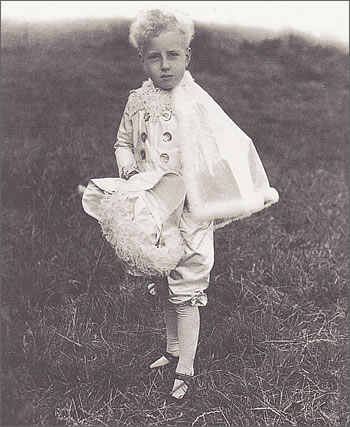
The Knabe in the postcard is aggressively blond and so must be a member of a German court. Why a rose is growing on a heath and what the page is doing wandering around in that rococo costume are questions that only the artist can answer. The courtly interpretation of Knabe is far from the world of Goethe's poem, but then, only the first line is reproduced on the card itself.
The artist of another postcard was also stimulated to medieval thoughts by Knabe, although avoiding the full fancy dress version. The shirt is courtly, not rustic. There is no shepherdess to distract the young man and the rose is effectively a solitary flower on the bush.
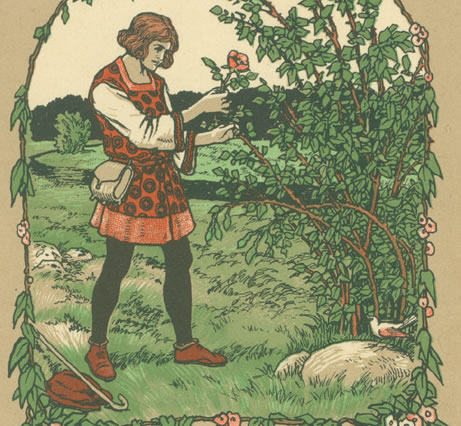
In the illustration below we see another relatively blasted heath, but no rose at all. Instead we have that traditional object of bucolic lust, a shepherdess. We are also presented with the symbolic function of the feather in the hat, here long and rakish. The girl is clutching her shawl chastely and defensively. Her crook is at the ready, so this may turn out to be a feminist parable after all.
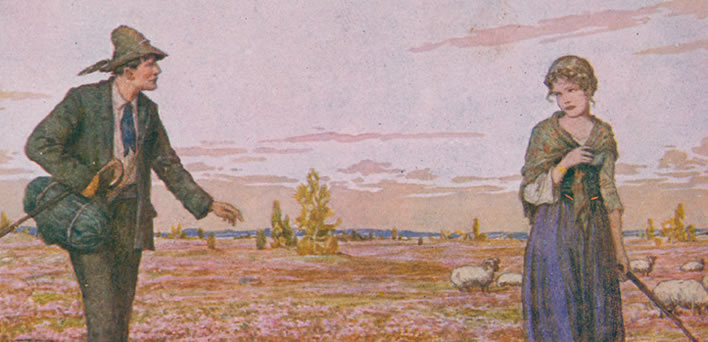
Staying with shepherdesses and feathered hats, but going completely off-piste by replacing the rose bush with that great German national symbol, the Linde, lime tree, we ponder Wilhelm von Kaulbach's 1867 illustration for Walter von der Vogelweide's poem Unter der Linden.
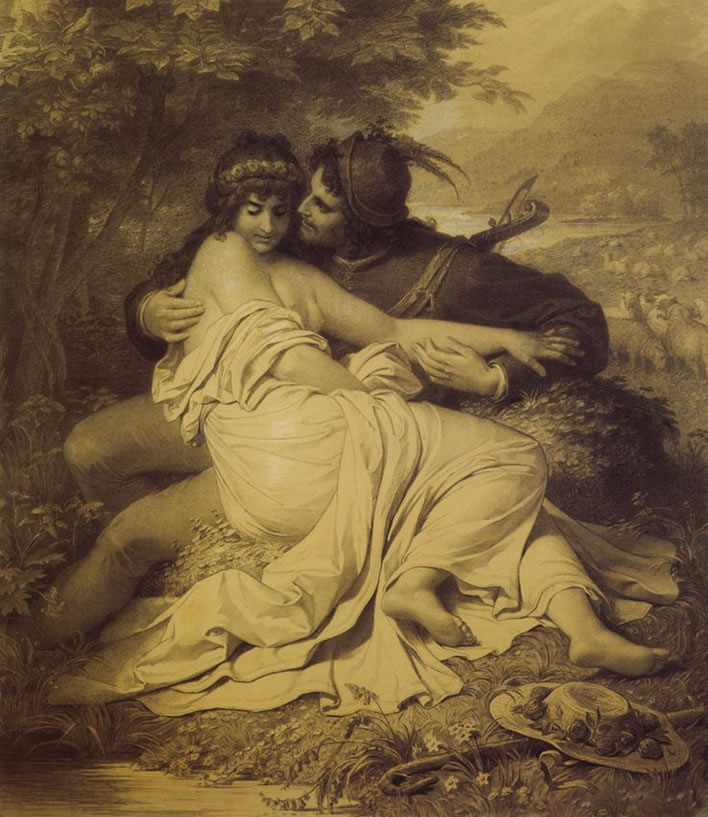
The girl has cast aside her crook, hat, shawl and nearly everying else, not a surprise since the poet has not one but two feathers in his hat.
The following illustration from an 1899 edition of Goethe's Faust shows Mephistopheles revealing in a dream to that dull drudge Dr Heinrich Faust what life could be like if only he would do a deal with him.
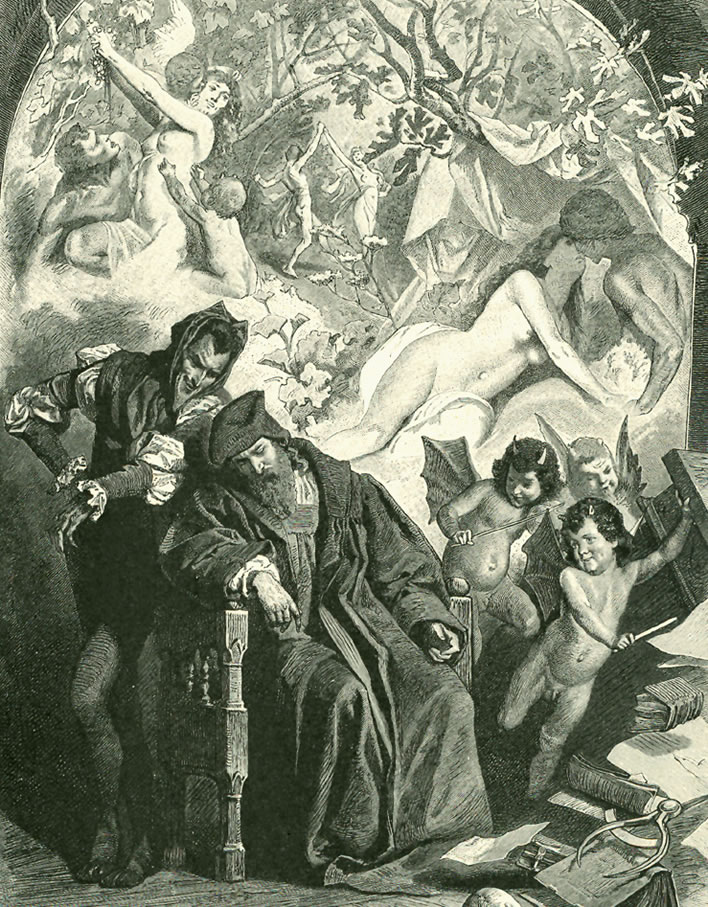
Deal done, Mephistopheles has made Faust irresistable to women. The frumpy academic cap has been dumped and Heinrich is now proudly flashing his huge feather at Gretchen, the chaste object of his desire. She will resist, but not for long – how could she? This is a family blog, so we won't talk about Faust's sword.

More Faust, more Devil, more feathers, this time from 1820. Gretchen, silly girl, is pulling petals off a marguerite (geddit?): 'He loves me, he loves me not'. Heinrich, the greatest and most subtle thinker of the age, appears to be very interested in this procedure.
![Umrisse zu Goethe's Faust, gezeichnet von [Moritz] Retsch, 1820 Umrisse zu Goethe's Faust, gezeichnet von [Moritz] Retsch, 1820](../../img/2017/06/Retsch_GoethesFaust_1820_452x418.jpg)
Now you see why all this nonsense was cut out of the original.
Update 25.07.2017
The section covering Goethe's return to Sesenheim in 1779 to visit Friederike Brion after eight years of separation was incorrect. It has now been corrected and extended.
0 Comments UTC Loaded:
Input rules for comments: No HTML, no images. Comments can be nested to a depth of eight. Surround a long quotation with curly braces: {blockquote}. Well-formed URLs will be rendered as links automatically. Do not click on links unless you are confident that they are safe. You have been warned!